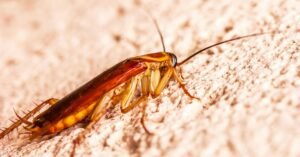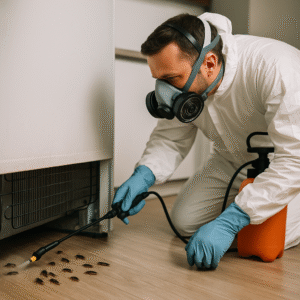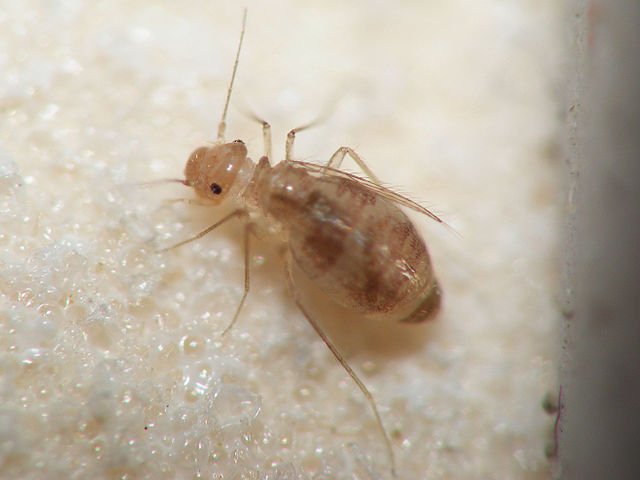How Long Does It Take to Get Rid of Roaches After Extermination?
 Wondering how long it takes to get rid of roaches after extermination? You’re not alone. Many people still see roaches after cockroach control and start to panic — but in most cases, this is totally normal. Here's what to expect.
Wondering how long it takes to get rid of roaches after extermination? You’re not alone. Many people still see roaches after cockroach control and start to panic — but in most cases, this is totally normal. Here's what to expect.
There are several factors that affect how fast you will see results. In this article, we’ll explain everything you need to know so you know what to expect and how to help the treatment from your side to work better.
1. Not All Roaches Are the Same
The first thing to understand is that different types of cockroaches behave differently. Some die quickly, others need more time. The most common species found in homes are:
American Cockroach
These are large, reddish-brown roaches.
They often come from drains, basements, or sewer lines — and sometimes they can even fly.
They usually live in the sewers, but in some cases, they may build nests inside the house.
If we locate and treat a nest indoors, 15 to 20 roaches can die within minutes.
If you see small roaches a few days later, don’t worry. It’s usually because an egg capsule (ootheca) has hatched. The young roaches (nymphs) will need to walk over the treated surfaces to get exposed to the pesticide. This is normal. The insecticide continues to work for 30 to 90 days, depending on the product used.
If the roaches are coming from outside, the situation is harder to control. They can appear from pipes, basements, neighboring buildings, or gardens. In these cases, it may take a few days to a week or more until you stop seeing them completely.
If the problem is external, it’s important to spray regularly, especially in balconies, terraces, and outdoor areas, to keep those places continuously protected.
Oriental Cockroach
These roaches are dark brown or almost black, and they are usually slower than other species.
They prefer cool and damp environments, such as basements, crawl spaces, laundry rooms, or areas with poor ventilation.
They behave somewhat like American cockroaches. If the infestation is mild and the treatment is applied directly, they can disappear within minutes.
However, if there's an egg capsule (ootheca) present — which can contain up to 40 eggs — you may still see young roaches hatching for several days after treatment. These will die once they come in contact with the treated surfaces.
If the building has ongoing issues, like humidity problems or roach movement from nearby apartments or drains, full elimination might take longer.
In such cases, regular follow-up treatments every two months may be needed to keep the population under control and prevent new infestations from surrounding areas.
German Cockroach
The German cockroach is small and light brown, with two dark stripes on its back, just behind the head.
It typically lives in kitchens, bathrooms, behind appliances, and inside drawers.
According to the University of Kentucky Entomology Department, German cockroaches reproduce faster than any other domestic species.
This species reproduces extremely fast and lays eggs constantly. It has a short biological cycle, which means infestations can grow quickly if not treated early.
It is considered the most difficult species to eliminate.
If the infestation is mild, they can be gone in 1 to 2 weeks.
In moderate to heavy infestations, it may take 3 to 6 weeks.
In larger infestations, a second treatment is often needed after 4 weeks.
In extreme cases, complete elimination can take more than 2 months.
2. How the Treatment Works (time needed to eliminate cockroaches)
 Cockroach control is not just about killing the ones you see. Most professional exterminators use a combination of different methods to target the whole colony, not just the visible roaches.
Cockroach control is not just about killing the ones you see. Most professional exterminators use a combination of different methods to target the whole colony, not just the visible roaches.
These methods usually include:
Residual sprays – These leave a layer of insecticide on surfaces, which continues to kill roaches for days or even weeks after application.
Gel baits – Especially effective against German cockroaches, baits are eaten by the roaches and carried back to the nest. They then share the poison with other roaches, creating a chain reaction.
Insect Growth Regulators (IGRs) – These don’t kill roaches immediately but stop them from growing or reproducing, which helps break the life cycle.
Traps – These are used to monitor activity and confirm if the population is going down after treatment.
With gel baits, results are not immediate. Roaches eat the bait, go back to their hiding spots, and spread the poison to others. This process takes time — usually a few days to a week.
Also, egg capsules (oothecae) are not affected by any product. They must hatch first, and only then can the young roaches (nymphs) walk on treated surfaces and die. This is why you may see small roaches for 2 to 3 weeks after treatment — but don’t worry, if the treatment was done right, they will die shortly after hatching.
3. Why You Still See Roaches After Extermination
Ηow fast does pest control kill roaches? Don’t panic. It’s completely normal to see some cockroaches after treatment. This doesn’t mean the extermination failed.
Possible reasons include:
Hidden eggs that were not exposed to the treatment and new nymphs hatching but dying soon after
Roaches coming out of hiding after the poison was applied
Delayed death from gel bait
As long as the number of roaches keeps dropping and you’re not seeing live adults everywhere, the treatment is doing its job.
4. When Is a Second Visit Needed?
In many cases, one visit is enough, especially if the infestation is light or the roaches are coming from outside (like American or Oriental cockroaches).
But in the case of German cockroaches, or if the problem has been present for a long time, a second treatment is strongly recommended.
We usually schedule the second visit 3 to 4 weeks after the first one.
This helps to catch any newly hatched roaches (called nymphs) and also to reinforce the effect of the products, especially the gel bait and the IGRs.
IGR stands for Insect Growth Regulator. It’s a special type of chemical that doesn’t kill roaches directly, but it stops them from growing into adults or reproducing. This helps to break the life cycle and prevent future infestations.
If you skip the second visit, the problem might return — especially if even a few roaches survive and begin laying eggs again.
5. What You Should Do After Treatment
Your job after the extermination is to support the treatment and help it work as effectively as possible. Here are the main tips:
Do not deep clean with bleach, strong chemicals, or hot water for at least 7 to 10 days. This could remove or weaken the insecticide.
Don’t spray anything over the bait or the treated areas — it will reduce the product’s effectiveness.
Keep the kitchen and bathroom dry and clean. Roaches need water to survive.
Fix any leaks under sinks, behind toilets, or near appliances.
Store food properly, and remove pet food or water bowls at night.
Seal cracks and holes where roaches might hide — especially near walls, baseboards, pipes, and cabinets.
Remove cardboard boxes as soon as they arrive, and avoid clutter. Roaches love to hide and breed in cardboard and messy storage areas.
Doing these things will help the treatment last longer and reduce the chances of reinfestation.
6. When Will I Know It’s Over?
Here’s a general timeline, depending on the type and level of infestation:
Mild infestation with American or Oriental: 1–7 days
Mild German infestation: 7–15 days
Moderate to heavy German infestation: 3–6 weeks, with a second visit
Very heavy infestation: up to 2 months, possibly 3 good treatments
The biggest mistake people make is expecting instant results. Cockroach treatments are not like mosquito spray. The goal is to destroy the entire colony, including hidden individuals and eggs. This takes time.
7. How to Prevent Roaches from Coming Back
Once the infestation is under control, the most important thing is to keep it that way. Roaches can come back if the conditions are right, even after a successful treatment.
Here are some extra prevention steps that really make a difference:
Avoid overloading cabinets and drawers. Roaches love tight, undisturbed spaces with no airflow. Keep storage areas neat and well-ventilated.
Declutter hidden areas like behind the fridge, under the oven, and under sinks. These are common long-term hiding spots people often forget.
Keep drains and sink overflows dry at night — especially in unused bathrooms or laundry rooms.
Check and seal pipe openings where plumbing enters the wall. Roaches often travel through wall voids from other apartments or units.
Don’t store paper bags or old newspapers in bulk — they can attract roaches and act as nesting material.
Inspect second-hand furniture or appliances before bringing them into your home. Roaches (especially German ones) can hide inside electronics, microwaves, or toasters.
Limit indoor humidity with fans or dehumidifiers if your home tends to be damp — especially in basements or ground floors.
Install mesh screens in drain openings and floor vents to prevent roaches from entering through the pipes.
For long-term protection, you can also schedule maintenance treatments every 3 to 6 months, especially in buildings with a known cockroach history or in densely populated areas.
8. Final Thoughts
Roaches are one of the most persistent pests in the world. But they can be eliminated — with the right tools, plan, patience and consistenvy in the tratment. Is not one off.
So, how long does it take to get rid of roaches after extermination?
Anywhere from 1 day to 6 weeks, depending on the species, infestation level, and conditions in your home.
If your pest control technician did a professional job and you follow their instructions, you should see clear improvement in the first 2 weeks. And with proper follow-up, you can be completely roach-free.
Disclaimer
This article is for informational purposes only. Pest control laws and approved chemicals vary by country. For best results and legal safety, we strongly recommend contacting a licensed pest control professional in your local area. Always make sure that the pest control technician is properly certified or licensed, depending on your country’s regulations. It’s important to confirm that they only use approved products and apply them exactly as instructed on the product label. In most places in Europe, UK, or USA, following label directions is not just best practice—it’s the law.

